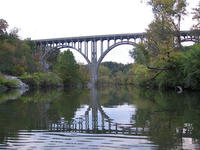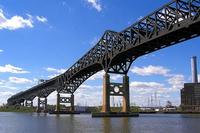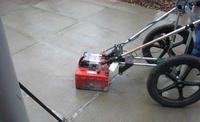-
Protecting U.S. bridges from terrorism, accident
More than 600,000 bridges in the United States are 20-feet long or longer, some over a century old, many of them national iconic monuments; DHS, the Federal Highway Administration, and the U.S. Army Corps of Engineers are conducting a series of tests aiming to make the bridges better able to withstand a terrorist attack; this research is discovering how materials, connection details, and designs in aging bridges react to IEDs, other explosives, kinetic impact, intense fires, and other accidents
-
-
Five arrested in foiled Cleveland bridge bomb plot

Five men who considered themselves anarchists and angry at the government and corporate America were arrested after a foiled attempt to blow up a Cleveland area bridge; the five were planning on commemorating May Day, the international workers’ holiday, by destroying the bridge connecting two wealthy Cleveland suburbs
-
-
Maintaining bridges and improving safety on a budget
What if there was a way to improve the safety, durability, and sustainability of aging bridges across North America without increasing spending? Researchers say they have found a way to do so
-
-
New Iowa bridge equipped with damage-detection gauges
A new Iowa bridge is equipped with sensors which provide a large amount of quantitative information about the bridge’s performance and condition; these gauges take 100 readings a second for corrosion, strain, surface conditions, moisture within the steel arch, and structure movements over time; the bridge is also equipped to monitor the security of the structure and to record surveillance video; it is a structure monitoring model that could be used for other new bridges, including much larger ones
-
-
U.S. aging bridges in critical condition

There are an estimated 18,000 bridges in the United States that are classed as fracture-critical bridges, requiring continual inspections; the need for increased inspection and maintenance runs against shrinking state and federal budgets for infrastructure improvements; bridges must also be closed for maintenance – but at least for that there is now a solution: instant bridges
-
-
Bridges get a quick check-up with new imaging technique

EPFL engineers have developed a new imaging technique which allows engineers to see the insides of massive concrete bridges; much like a sonogram, this technique provides quick, easy-to-interpret images, so that the health of these expensive structures can be assessed and monitored
-
-
£5 million investment in U.K. rail technology, business innovation
The U.K. government is leading on an investment of £5 million to accelerate business innovation and growth in the U.K. rail industry, using the funds to support the development of technologies to address technological and business challenges
-
-
Simulations helps overcome design challenges
Simulation software can pull volumes of complex data beyond simple measurements (think comparative load or stress tolerances) and layer that information into images; simulation can show how a bridge will perform based on how it is used, the conditions around it, its design, materials, and even variables such as the position of a joint — before a single component is manufactured or ground is broken
-
-
NICB warns of growing copper thefts
A recently released report by the National Insurance Crime Bureau (NICB) concludes that copper and other metal thefts are on the rise once again in the United States
-
-
Reducing fatalities in traffic’s “twilight zone”

There are more than 30,000 traffic fatalities each year in the United States, and about 2,000 of them occur in stoplight intersections; engineers call them “dilemma zone” — that area before a stoplight intersection where the traffic light turns yellow and the driver is not sure whether to stop or go ahead
-
-
New material for sustainable road building: "poticrete"
An organization dedicated to promoting sustainable roadway construction, awarded its first official certification to a Bellingham, Washington, project that incorporates porcelain from recycled toilets; a newly widened sidewalk in Bellingham incorporates more than 400 recycled toilets, crushed into what the project engineers have dubbed “poticrete”
-
-
Robots to climb and assemble structures, making construction safer

In the near future, armies of robots could nimbly be crawling up towers and skyscrapers to make repairs, so humans do not have to; the design of the truss pieces, which have ridges and specially designed locks so the robot can manipulate them, is as important as the robot itself, and researchers express the hopes that in the future such robot-friendly building components would be standardized for widespread use
-
-
Physicists predict when brittle materials fail
It does not happen often, but structures like bridges, airplanes, and buildings do fail, sometimes catastrophically; what are the odds, and how can it be prevented? Researchers just published new theoretical insights into the probability of structural failures, based on hundreds of thousands of computer simulations
-
-
Recycled glass in cement makes concrete stronger
Researchers have found that by mixing ground waste glass into the cement that is used to make concrete, the concrete is stronger, more durable, and more resistant to water; in addition, the use of glass helps reduce the amount of glass that ends up in landfills
-
-
Invisibility cloak to protect buildings from earthquakes
Scientists show that by cloaking components of structures with pressurized rubber, powerful waves such as those produced by an earthquake would not “see” the building — they would simply pass around the structure and thus prevent serious damage or destruction
-
- All
- Regional
- Water
- Biometrics
- Borders/Immig
- Business
- Cybersecurity
- Detection
- Disasters
- Government
- Infrastructure
- International
- Public health
- Public Safety
- Communication interoperabillity
- Emergency services
- Emergency medical services
- Fire
- First response
- IEDs
- Law Enforcement
- Law Enforcement Technology
- Military technology
- Nonlethal weapons
- Nuclear weapons
- Personal protection equipment
- Police
- Notification /alert systems
- Situational awareness
- Weapons systems
- Sci-Tech
- Sector Reports
- Surveillance
- Transportation
Advertising & Marketing: advertise@newswirepubs.com
Editorial: editor@newswirepubs.com
General: info@newswirepubs.com
2010-2011 © News Wire Publications, LLC News Wire Publications, LLC
220 Old Country Road | Suite 200 | Mineola | New York | 11501
Permissions and Policies
Editorial: editor@newswirepubs.com
General: info@newswirepubs.com
2010-2011 © News Wire Publications, LLC News Wire Publications, LLC
220 Old Country Road | Suite 200 | Mineola | New York | 11501
Permissions and Policies
